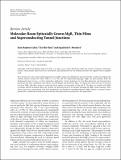| dc.contributor.author | Laloe, Jean-Baptiste | |
| dc.contributor.author | Kim, Tae Hee | |
| dc.contributor.author | Moodera, Jagadeesh | |
| dc.date.accessioned | 2011-08-26T18:30:36Z | |
| dc.date.available | 2011-08-26T18:30:36Z | |
| dc.date.issued | 2011-04 | |
| dc.date.submitted | 2008-02 | |
| dc.identifier.issn | 1687-8124 | |
| dc.identifier.issn | 1687-8108 | |
| dc.identifier.uri | http://hdl.handle.net/1721.1/65416 | |
| dc.description.abstract | Since the discovery of its superconducting properties in 2001, magnesium diboride has generated terrific scientific and engineering research interest around the world. With a
𝑇
Since the discovery of its superconducting properties in 2001, magnesium diboride has generated terrific scientific and engineering research interest around the world. With a T[subscript C] of 39 K and two superconducting gaps, MgB[subscript 2] has great promise from the fundamental point of view, as well as immediate applications. Several techniques for thin film deposition and heterojunction formation have been established, each with its own advantages and drawbacks. Here, we will present a brief overview of research based on MgB[subscript 2] thin films grown by molecular beam epitaxy coevaporation of Mg and B. The films are smooth and highly crystalline, and the technique allows for virtually any heterostructure to be formed, including all-MgB2 tunnel junctions. Such devices have been characterized, with both quasiparticle and Josephson tunneling reported. MgB[subscript 2] remains a material of great potential for a multitude of further characterization and exploration research projects and applications. | en_US |
| dc.description.sponsorship | United States. Office of Naval Research (Grant number N00014-02-1-0119) | en_US |
| dc.description.sponsorship | United States. Office of Naval Research (Grant number N00014-06-1-0235) | en_US |
| dc.language.iso | en_US | |
| dc.publisher | Hindawi Pub. Corp. | en_US |
| dc.relation.isversionof | http://dx.doi.org/10.1155/2011/989732 | en_US |
| dc.rights | Creative Commons Attribution | en_US |
| dc.rights.uri | http://creativecommons.org/licenses/by/2.0/ | en_US |
| dc.source | Hindawi | en_US |
| dc.title | Molecular-Beam Epitaxially Grown MgB2 Thin Films and Superconducting Tunnel Junctions | en_US |
| dc.type | Article | en_US |
| dc.identifier.citation | Laloë, Jean-Baptiste, Tae Hee Kim, and Jagadeesh S. Moodera. “Molecular-Beam Epitaxially Grown MgB2 Thin Films and Superconducting Tunnel Junctions.” Advances in Condensed Matter Physics 2011 (2011) : 1-9. | en_US |
| dc.contributor.department | Massachusetts Institute of Technology. Department of Physics | en_US |
| dc.contributor.department | Francis Bitter Magnet Laboratory (Massachusetts Institute of Technology) | en_US |
| dc.contributor.approver | Laloe, Jean-Baptiste | |
| dc.contributor.mitauthor | Laloe, Jean-Baptiste | |
| dc.contributor.mitauthor | Moodera, Jagadeesh | |
| dc.relation.journal | Advances in Condensed Matter Physics | en_US |
| dc.eprint.version | Final published version | en_US |
| dc.type.uri | http://purl.org/eprint/type/JournalArticle | en_US |
| eprint.status | http://purl.org/eprint/status/PeerReviewed | en_US |
| dspace.orderedauthors | Laloë, Jean-Baptiste; Kim, Tae Hee; Moodera, Jagadeesh S. | en |
| dc.identifier.orcid | https://orcid.org/0000-0002-2480-1211 | |
| mit.license | PUBLISHER_CC | en_US |
| mit.metadata.status | Complete | |
